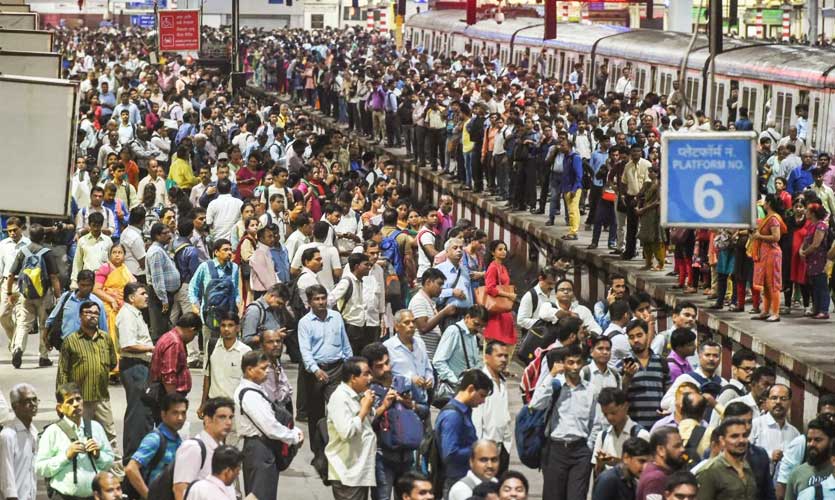The recent decision of two BJP governed states – Uttar Pradesh (UP) and Assam – to implement a population control strategy, is in line with a countrywide plan to address what the RSS terms as “demographic imbalance”.
On Sunday, UP, the country’s most populated state which is home to an estimated 220 million people, unveiled a new policy targeted to incentivise population management. The state’s law commission has developed a draft bill – the Uttar Pradesh Population (Control, Stabilisation, and Welfare) Bill, 2021 – to entice people to not have more than two children through priority in government employment, and social programmes such as free or subsidised rationing. According to the state’s draft bill, those who have more than two children would be disqualified for government employment and promotions and from getting benefits from different programmes.
A similar approach is being considered in Assam. The state, which has a population of 36 million people, is also exploring a two-child policy to get access to government programmes. The government implemented the Population and Women Empowerment Policy in 2017, which required government personnel to adhere to the two-child standard. Notably, the state’s SC and ST populations and tea garden employees will be excluded from this regulation.
The union Minister of Rural Development Giriraj Singh has praised the UP government’s population control strategy and advocated for a similar law in Bihar to curb the state’s exponential population increase.
However, the Janata Dal (United) leaders, who are BJP’s allies in Bihar, condemned it as an electoral tactic to polarise voters in UP ahead of the state elections and said it should be rejected. The JDU’s claim was also supported by Congress, which stated that implementing any such regulation requires political unanimity.
It’s no surprise that a low population has been regarded as a benefit to economic progress. Modern capitalism as we know it emerged in the less densely populated areas of Western Europe and North America (except for Japan). Densely populated nations with enormous populations such as China and India, have lately joined the ranks of the world’s greatest economies only recently.
The religious polarisation around population control makes it an even more difficult issue in India. The bogey of population expansion is frequently used, directly or indirectly, to politically attack Muslims, the country’s biggest religious minority group. For example, while emphasising the need for population control in reducing poverty, Assam’s chief minister Himanta Biswa Sarma recently encouraged minority community stakeholders to talk with members to work toward efficient population control measures.
Population Growth Peaked A Long Time Ago
By 2025, or maybe sooner, India may have surpassed China as the world’s most populous country. This, however, should not be interpreted as implying that India is experiencing a population surge. According to these demographic statistics, India’s population growth peaked decades ago and has since been declining. According to the United Nations’ population predictions, India’s population will grow by a factor of 1.09 between 2021 and 2031. Between 1981 and 1991, this figure was 1.25. India’s population will begin to decline beginning in 2060 when fertility rates fall below replacement levels. According to the UN’s predictions, India’s population will reach 1.2 billion by 2100.
Higher Fertility Rate Among Uneducated And Poor Women
The macro figures on India’s population do not negate the fact that having a greater number of children is an issue. The evidence at hand, from the National Family and Health Survey (NFHS) findings in 2015-16 (the most recent accessible all-India data), points to what is well established in the theory of demographic transition. The total fertility rates (TFR) are greater among the poor and decline as wealth rises. The TFR is the average number of children a woman carries throughout her lifetime. Women’s education also has an influence, both in terms of fertility rates and the age of the mother at the time of her first child’s birth.
Read more: Disabled Children Brainwashed To Become Human Bombs In UP Forced Conversion Racket
Real Impact Of The Policies
The notion that Muslims have greater fertility rates in India has some validity to it. While some of this may be explained by their greater socio-economic backwardness, the NFHS data reveals that Muslims have a larger percentage of married women with more than two children, than Hindus, even in the same education and wealth cohorts.
Perhaps it is this reality that fosters the blending of political discourse about population control with religious speech. However, even with a higher fertility rate, the Muslim population is still in the minority. What the proponents of such measures fail to see is that if the government enacts rules that exclude families with more than two children, a larger percentage of those impacted would be Hindus. Not only is such a policy regressive, it will harm the economically challenged more and will also fail to accomplish its “sectarian goal” since Hindus will suffer more than Muslims.
Patriarchy Driven Preferences
India’s deeply ingrained cultural views, patriarchy being one of the most powerful, contribute to rising fertility rates. According to the 2015-16 NFHS data, whether one of the first two children was a son had a substantial effect on the desire to have a third child. If they had two boys, 89 percent of women and 92 percent of men did not desire a third child. This figure fell to 63 percent and 64 percent for those men and women respectively, who had two children but no sons. Such predilection is said to have harmed the population’s sex ratio via behaviours such as female foeticide, among others. Many studies have indicated that this mindset is more prevalent among the comparatively well-off, particularly in northern areas.










